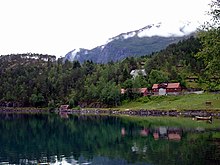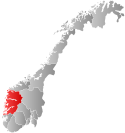|
Stryn
Stryn is a municipality in the county of Vestland, Norway. It is located in the traditional district of Nordfjord. The administrative center of the municipality is the village of Stryn. The municipality is located along the innermost part of the Nordfjorden. Some of the main villages in Stryn include Loen, Innvik, Utvik, Randabygda, Olden, and Flo.    Farming, forestry, fruit growing, animal breeding for furs, small manufacturing industries, tourism, and the service trades provide the main occupations. The river Stryneelva enters the village of Stryn from the east after passing through the Stryn Valley, from the large lake Oppstrynsvatn. The Jostedalsbreen National Park Centre is on the shore of the lake. Stryn has all year glacier skiing at Stryn Sommerski. It is also the home of the footballer-brothers Tore André Flo, Jarle Flo and Jostein Flo, who grew up in the village of Stryn, as well as their footballing-cousin Håvard Flo who is from the village of Flo. The 1,382-square-kilometre (534 sq mi) municipality is the 67th largest by area out of the 356 municipalities in Norway. Stryn is the 140th most populous municipality in Norway with a population of 7,244. The municipality's population density is 5.5 inhabitants per square kilometre (14/sq mi) and its population has increased by 2% over the previous 10-year period.[4][5] General informationInnvik was established as a municipality on 1 January 1838 (see formannskapsdistrikt law). The original municipality was identical to the Innvik parish (prestegjeld) with the sub-parishes (sokn) of Oppstryn, Nedstryn, Loen, Olden, Innvik, and Utvik. In 1843, the sub-parishes of Loen, Oppstryn, and Nedstryn were separated from the municipality of Innvik and became a separate municipality named Stryn. The population of Stryn at this time was 2,401. On 10 January 1922, the area of Raksgrenda was transferred from Innvik to Stryn. The population in this area was 120 at that time.[6] During the 1960s, there were many municipal mergers across Norway due to the work of the Schei Committee. On 1 January 1965, a merger took place combining the following areas into a new Stryn municipality:[6]
Initially, this new municipality of Stryn had a population of 7,211. On 1 January 1977, the parts of the old Hornindal Municipality that were merged with Stryn in 1965 were transferred back to the newly re-constituted Hornindal municipality. The population of Stryn was reduced by 1,202 in this transaction.[6] On 1 January 2019, the Maurset area in the southern part of the neighboring municipality of Hornindal (population: 19) was transferred from Hornindal to Stryn.[7] On 1 January 2020, the municipality became part of the newly created Vestland county after Sogn og Fjordane and Hordaland counties were merged. NameThe municipality (originally the parish) is likely named after the local river Stryneelva (Old Norse: Strjónar). The name is derived from the word strjónn which means "(strong) stream".[8] Coat of armsThe coat of arms was granted on 11 December 1987. The official blazon is "Vert, a linden branch Or in bend sinister with four leaves" (Norwegian: På grønn grunn ein venstre skråstilt gull lindekvist med fire blad). This means the arms have a green field (background) and the charge is a linden (tilia) branch with four leaves. The charge has a tincture of Or which means it is commonly colored yellow, but if it is made out of metal, then gold is used. The linden was chosen to represent the vast deciduous forests in the region, the branch represents the main fjord through the municipality, and the four leaves were chosen to represent the four main village areas along the fjord. The arms were designed by Heidi Heggdal. The municipal flag has the same design as the coat of arms.[9][10][11]   ChurchesThe Church of Norway has eight parishes (sokn) within the municipality of Stryn. It is part of the Nordfjord prosti (deanery) in the Diocese of Bjørgvin.[12]
GovernmentStryn Municipality is responsible for primary education (through 10th grade), outpatient health services, senior citizen services, welfare and other social services, zoning, economic development, and municipal roads and utilities. The municipality is governed by a municipal council of directly elected representatives. The mayor is indirectly elected by a vote of the municipal council.[13] The municipality is under the jurisdiction of the Sogn og Fjordane District Court and the Gulating Court of Appeal. Municipal councilThe municipal council (Kommunestyre) of Stryn is made up of 25 representatives that are elected to four year terms. The tables below show the current and historical composition of the council by political party.
MayorsThe mayor (ordførar) of a municipality in Norway is a representative of the majority party of the municipal council who is elected to lead the council. The mayors of Stryn:
Geography     LocationStryn is located on the northern border of Vestland county. To the north, Stryn is bordered by the municicaplities of Volda and Stranda (in Møre og Romsdal county), to the east is Skjåk (in Innlandet county), to the southeast is Luster, to the southwest is Sunnfjord, and to the west is Gloppen and Stad. NatureStryn is known for its scenery, glaciers and the mountains running into the mirroring fjords and lakes. The glacier Briksdalsbreen lies in the Oldedalen valley. The Stryn area also has a number of other valley glaciers including Tindefjellbreen, Tystigsbreen, and Myklebustbreen. Most of the valley glaciers in Stryn are originating from the great Jostedal glacier (Jostedalsbreen) between the Nordfjord and Sogn areas. Ramnefjellsfossen, the third highest free-falling waterfall in the world, is located in the municipality. Stryn also has the largest linden forest in Northern Europe. The largest lakes are Oppstrynsvatn, Lovatnet, and Oldevatnet. The mountains Skåla, Lodalskåpa, and Høgstre Breakulen are all located in Stryn. Jostedal Glacier National ParkThe Jostedalsbreen National Park has an area of approximately 1,310 square kilometres (510 sq mi). Flora and fauna area is situated between the fjord and glacier. The museum Jostedalsbreen nasjonalparksenter is located in Oppstryn. Briksdal glacierVisitors from all over the world come to see the Briksdalsbreen glacier outlet, which is situated amid waterfalls and high peaks. Briksdal glacier is a part of the Jostedal glacier ice field, which is the largest glacier on the European mainland. The highest point of the glacier lies at 1,950 metres (6,400 ft) above sea level and in some places it measures 400 metres (1,300 ft) in depth. It is located at the end of the Oldedalen valley. Lodalen–KjenndalenOn two occasions, large rockslides from Ramnefjellet hit the lake below. The resulting flood wave wiped out the settlements of Nesdal and Bødal, killing 135 people. WildlifeThere are many bird species in this area including the golden eagle (Aquila chrysaetos), rough-legged buzzard (Buteo lagopus), and the white-backed woodpecker (Dendrocopus leucotos). Some of the larger mammals that live in this region are red deer (Cervus elaphus), wolverines (Gulo gulo), and lynxes (Lynx lynx). AttractionsNational Tourist RouteThe Gamle Strynefjellsvegen is a National Tourist Route (Fylkesvei 258). It goes from Grotli (Skjåk municipality in Innlandet county) to Videseter, where a waterfall is, and on to the village of Stryn (Vestland county). Stryn CenterThe village of Stryn, a busy and developing small village at the tip of the most northernly of the three short branches at the inner end of Nordfjorden, is the local government and shopping centre for a large community and the junction of roads which connect inner Nordfjord with the rest of Norway. Oldedalen ValleyThe southernmost of the three short branches at the inner end of Nordfjorden terminates at the village of Olden from which a lovely valley, Oldedalen, goes due south for about 20 kilometres (12 mi) between slopes rising sharply to more than 1,700 metres (5,600 ft) to the edge of the Jostedals glacier. Olden has two churches. The Old Olden Church in the village, was built in 1759 on the site of a Stave church dating from around 1300. Its pews, doors, and jambs are made from timbers of the Stave church. The "new" Olden Church, a short distance along the valley, was built in 1934 so that the old church could be preserved. Loen and Lodalen ValleyThe Loen Skylift is located in Loen, and Hotel Alexandra is a popular tourist retreat. Loen Valley (Lodalen) is a popular attraction, and Kjenndal Glacier is located at the end of the valley (branch of the Jostedal Glacier). Much of the upper Loen valley was devastated from two rockfall slides (one in 1905 and one in 1936) that created huge waves that swept with them most of the houses and vegetation. A total of 135 people were killed in these two incidents. Innvik and UtvikOn the southern shore of the Nordfjorden, between Hildaneset and Utvikfjellet, lie the villages of Innvik and Utvik, in the area known as Vikane. The main road (Rv 60) skirts the fjord past Innvik and ascends from Utvik to Utvikfjellet mountain. At Hildaneset, beside the main road, there is a sculpture of Mr. Singer. Mr Singer financed the building of the road. Notable people
Sport
References
External linksWikimedia Commons has media related to Stryn. Wikivoyage has a travel guide for Stryn.
|
||||||||||||||||||||||||||||||||||||||||||||||||||||||||||||||||||||||||||||||||||||||||||||||||||||||||||||||||||||||||||||||||||||||||||||||||||||||||||||||||||||||||||||||||||||||||||||||||||||||||||||||||||||||||||||||||||||||||||||||||||||||||||||||||||||||||||||||||||||||||||||||||||||||||||||||||||||||||||||||||||||||||||||||||||||||||||||||||||||||||||||||||||||||||||||||||||||||||||||||||||||||||||||||||||||||||||||||||||||||||||||||||||||||||||||||||||||||||||||||||||||||||||||||||||||||||||||||||||||||||||||||||||||||||||||||||||||||||||||||||||||||||||||||||||||||||||||||||||||||||||||||||||||||||||||||||||
Portal di Ensiklopedia Dunia





